2017 NISSAN MAXIMA window
[x] Cancel search: windowPage 10 of 406
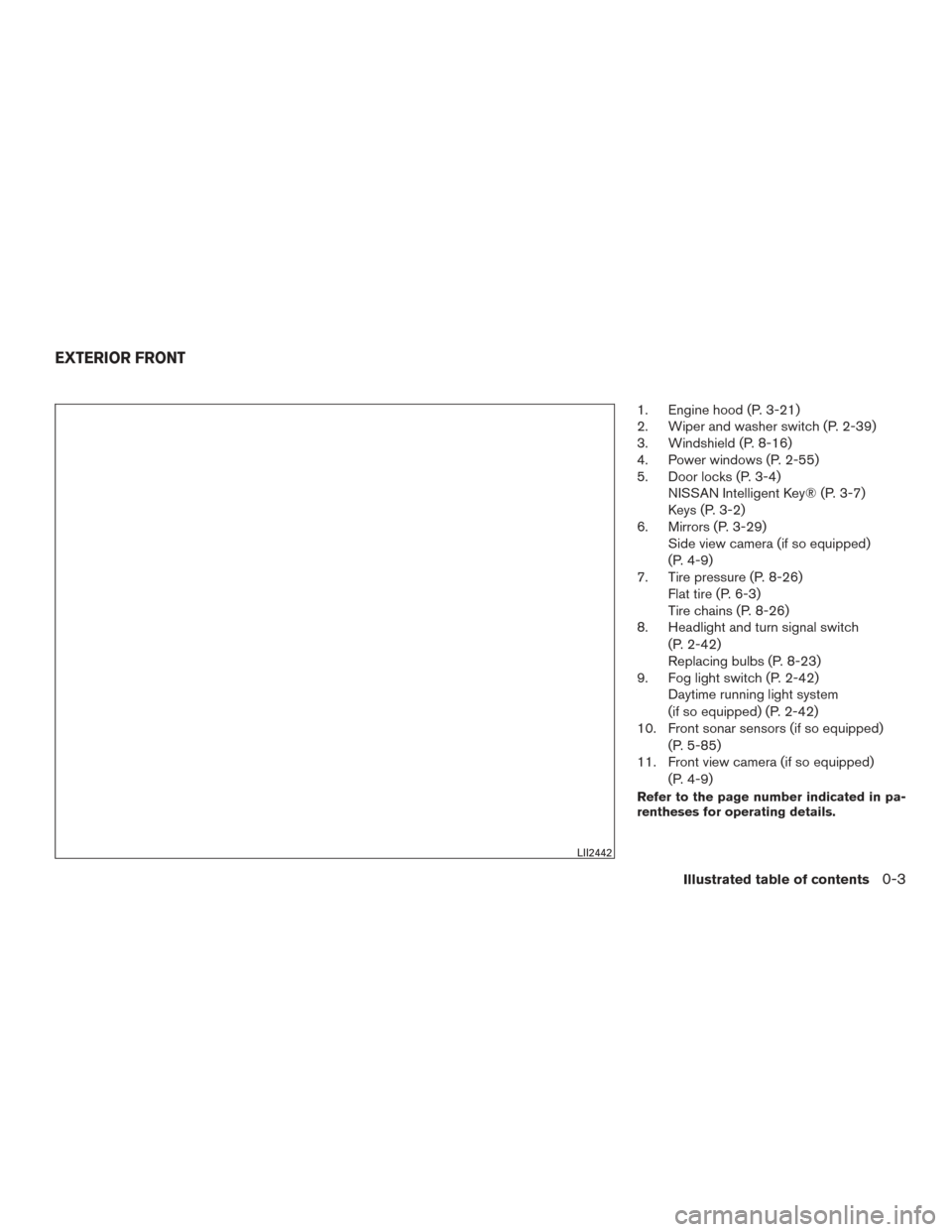
1. Engine hood (P. 3-21)
2. Wiper and washer switch (P. 2-39)
3. Windshield (P. 8-16)
4. Power windows (P. 2-55)
5. Door locks (P. 3-4)NISSAN Intelligent Key® (P. 3-7)
Keys (P. 3-2)
6. Mirrors (P. 3-29) Side view camera (if so equipped)
(P. 4-9)
7. Tire pressure (P. 8-26) Flat tire (P. 6-3)
Tire chains (P. 8-26)
8. Headlight and turn signal switch
(P. 2-42)
Replacing bulbs (P. 8-23)
9. Fog light switch (P. 2-42) Daytime running light system
(if so equipped) (P. 2-42)
10. Front sonar sensors (if so equipped)
(P. 5-85)
11. Front view camera (if so equipped)
(P. 4-9)
Refer to the page number indicated in pa-
rentheses for operating details.
LII2442
EXTERIOR FRONT
Illustrated table of contents0-3
Page 11 of 406
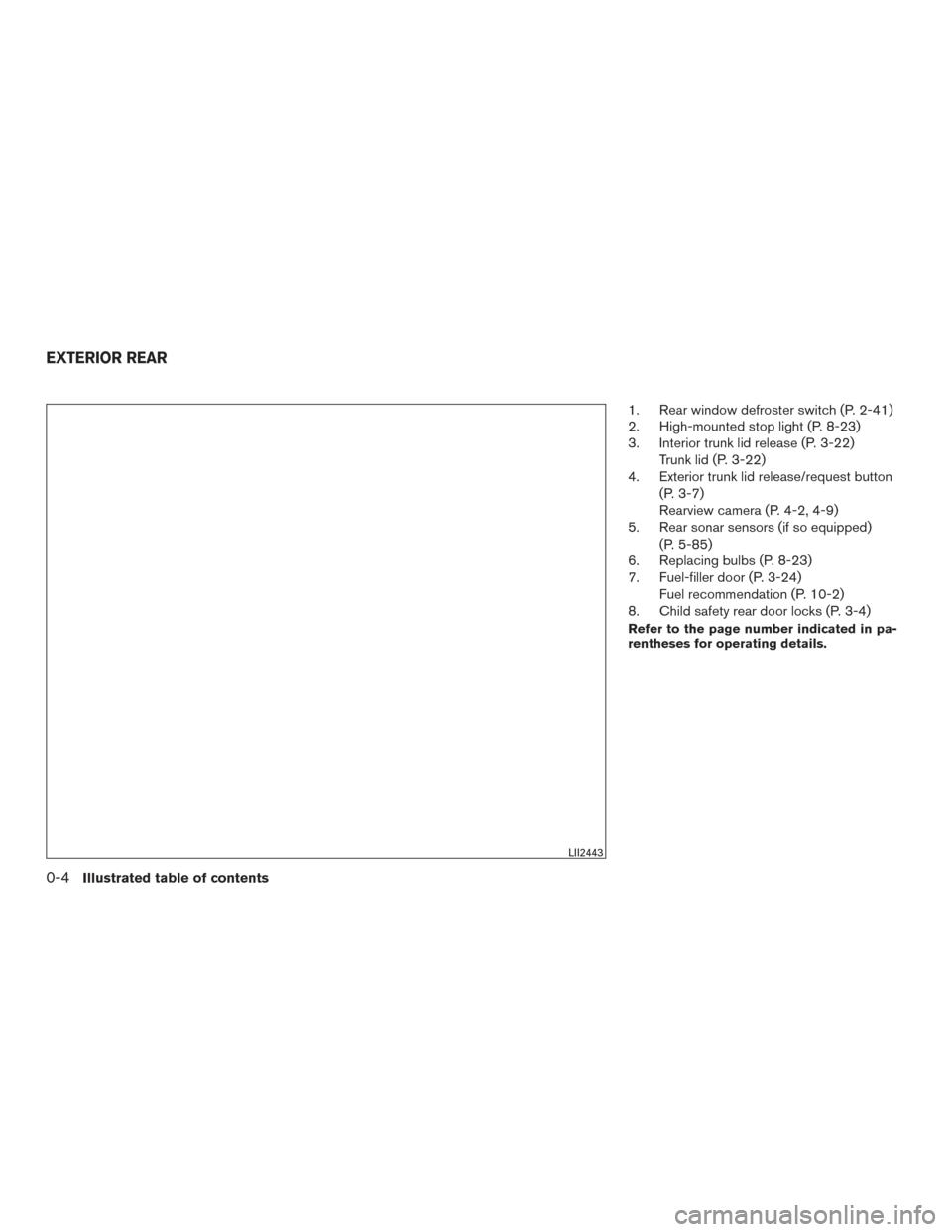
1. Rear window defroster switch (P. 2-41)
2. High-mounted stop light (P. 8-23)
3. Interior trunk lid release (P. 3-22)Trunk lid (P. 3-22)
4. Exterior trunk lid release/request button
(P. 3-7)
Rearview camera (P. 4-2, 4-9)
5. Rear sonar sensors (if so equipped)
(P. 5-85)
6. Replacing bulbs (P. 8-23)
7. Fuel-filler door (P. 3-24) Fuel recommendation (P. 10-2)
8. Child safety rear door locks (P. 3-4)
Refer to the page number indicated in pa-
rentheses for operating details.
LII2443
EXTERIOR REAR
0-4Illustrated table of contents
Page 61 of 406
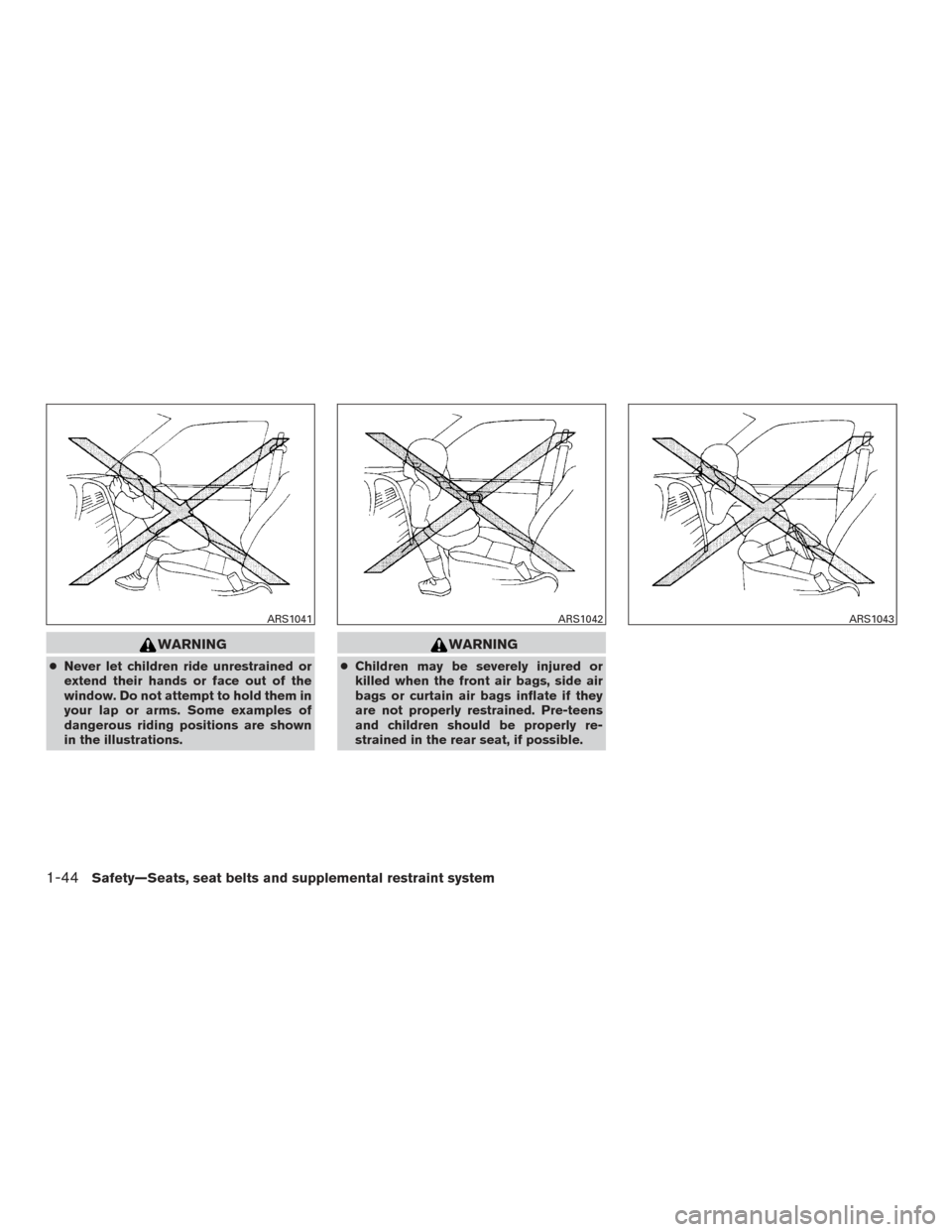
WARNING
●Never let children ride unrestrained or
extend their hands or face out of the
window. Do not attempt to hold them in
your lap or arms. Some examples of
dangerous riding positions are shown
in the illustrations.
WARNING
● Children may be severely injured or
killed when the front air bags, side air
bags or curtain air bags inflate if they
are not properly restrained. Pre-teens
and children should be properly re-
strained in the rear seat, if possible.
ARS1041ARS1042ARS1043
1-44Safety—Seats, seat belts and supplemental restraint system
Page 63 of 406
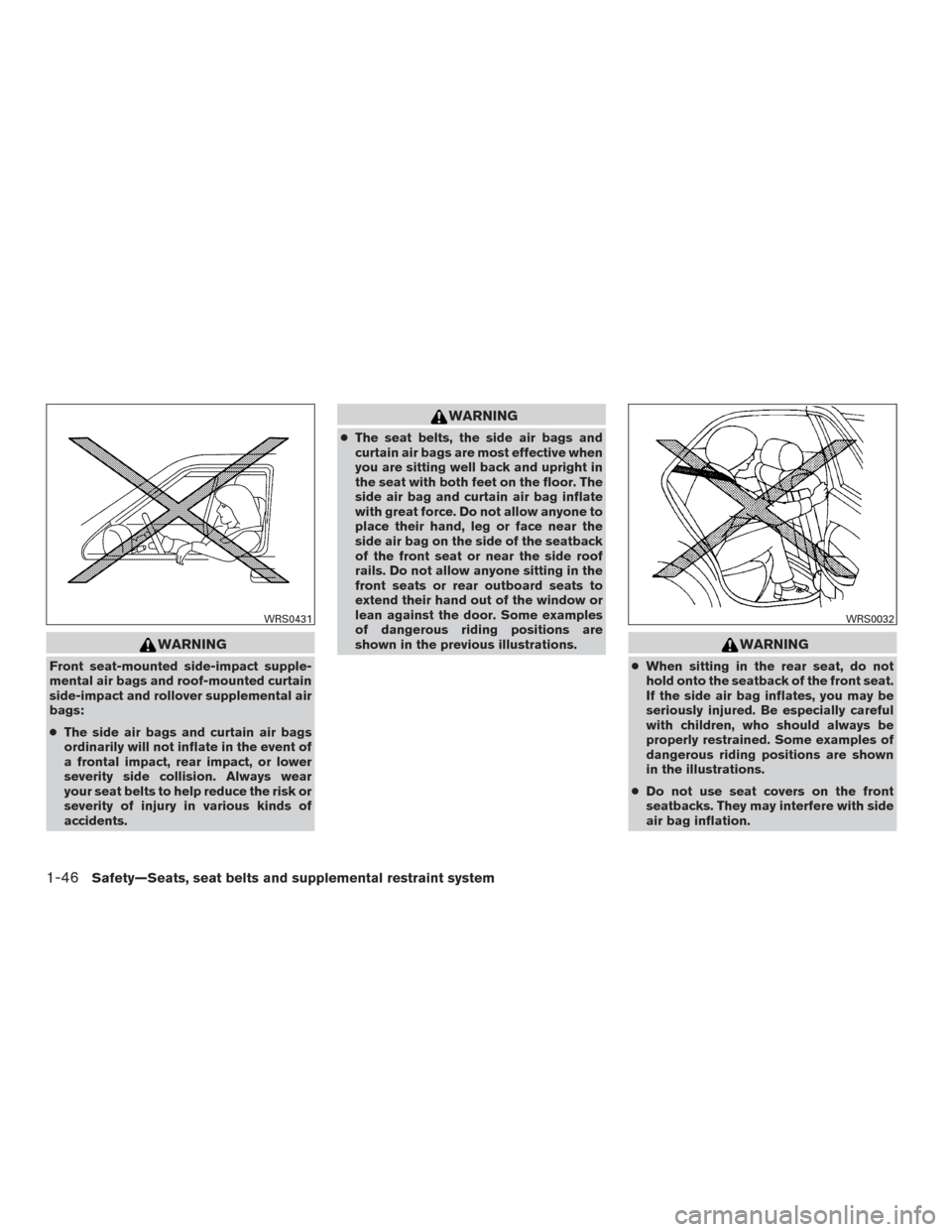
WARNING
Front seat-mounted side-impact supple-
mental air bags and roof-mounted curtain
side-impact and rollover supplemental air
bags:
●The side air bags and curtain air bags
ordinarily will not inflate in the event of
a frontal impact, rear impact, or lower
severity side collision. Always wear
your seat belts to help reduce the risk or
severity of injury in various kinds of
accidents.
WARNING
● The seat belts, the side air bags and
curtain air bags are most effective when
you are sitting well back and upright in
the seat with both feet on the floor. The
side air bag and curtain air bag inflate
with great force. Do not allow anyone to
place their hand, leg or face near the
side air bag on the side of the seatback
of the front seat or near the side roof
rails. Do not allow anyone sitting in the
front seats or rear outboard seats to
extend their hand out of the window or
lean against the door. Some examples
of dangerous riding positions are
shown in the previous illustrations.
WARNING
● When sitting in the rear seat, do not
hold onto the seatback of the front seat.
If the side air bag inflates, you may be
seriously injured. Be especially careful
with children, who should always be
properly restrained. Some examples of
dangerous riding positions are shown
in the illustrations.
● Do not use seat covers on the front
seatbacks. They may interfere with side
air bag inflation.
WRS0431WRS0032
1-46Safety—Seats, seat belts and supplemental restraint system
Page 79 of 406
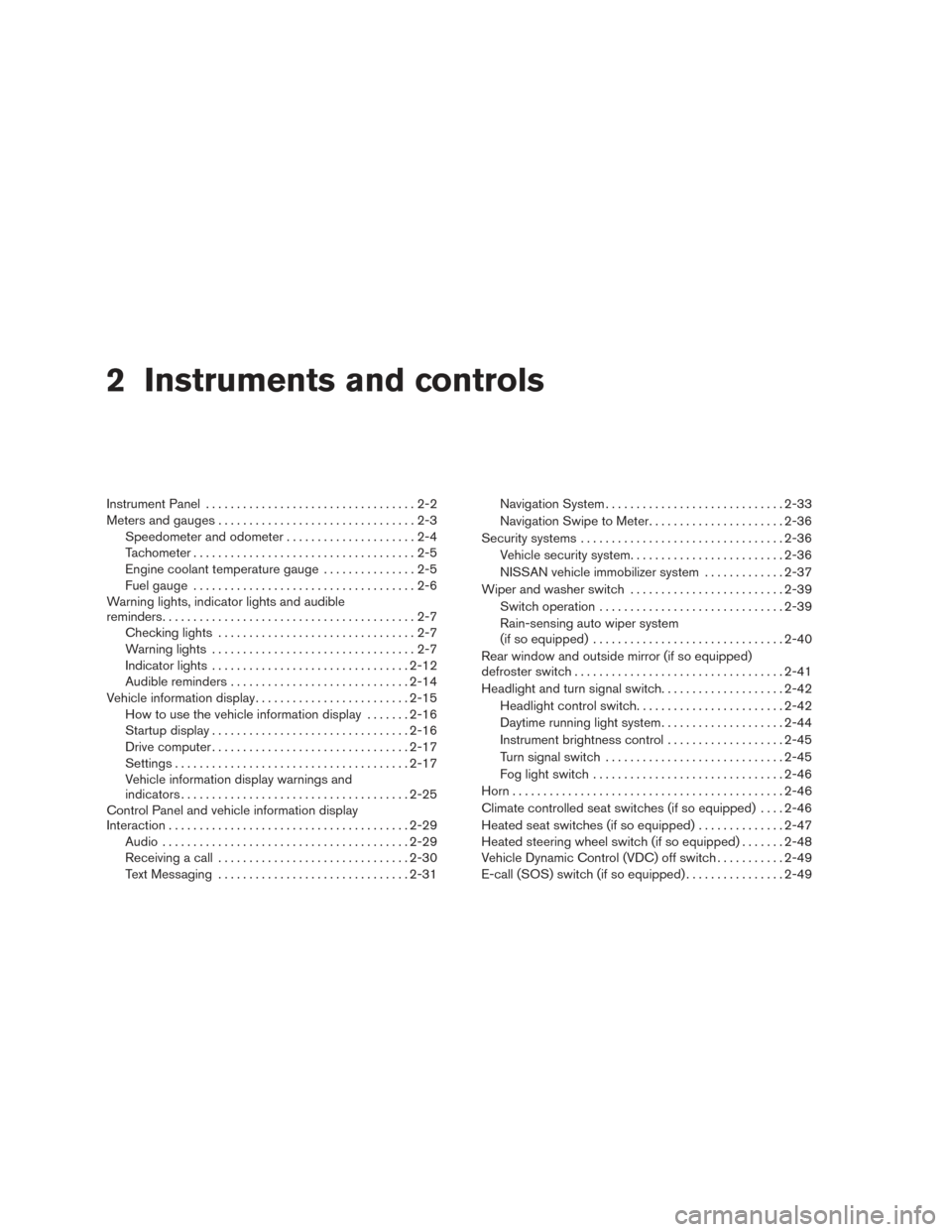
2 Instruments and controls
Instrument Panel..................................2-2
Meters and gauges ................................2-3
Speedometer and odometer .....................2-4
Tachometer ....................................2-5
Engine coolant temperature gauge ...............2-5
Fuel gauge ....................................2-6
Warning lights, indicator lights and audible
reminders .........................................2-7
Checking lights ................................2-7
Warning lights .................................2-7
Indicator lights ................................ 2-12
Audible reminders ............................. 2-14
Vehicle information display ......................... 2-15
How to use the vehicle information display .......2-16
Startup display ................................ 2-16
Drive computer ................................ 2-17
Settings ...................................... 2-17
Vehicle information display warnings and
indicators ..................................... 2-25
Control Panel and vehicle information display
Interaction ....................................... 2-29
Audio ........................................ 2-29
Receiving a call ............................... 2-30
Text Messaging ............................... 2-31Navigation System
............................. 2-33
Navigation Swipe to Meter ......................2-36
Security systems ................................. 2-36
Vehicle security system ......................... 2-36
NISSAN vehicle immobilizer system .............2-37
Wiper and washer switch ......................... 2-39
Switch operation .............................. 2-39
Rain-sensing auto wiper system
(if so equipped) ............................... 2-40
Rear window and outside mirror (if so equipped)
defroster switch .................................. 2-41
Headlight and turn signal switch ....................2-42
Headlight control switch ........................ 2-42
Daytime running light system ....................2-44
Instrument brightness control ...................2-45
Turn signal switch ............................. 2-45
Fog light switch ............................... 2-46
Horn ............................................ 2-46
Climate
controlled seat switches (if so equipped) ....2-46
Heated seat switches (if so equipped) ..............2-47
Heated steering wheel switch (if so equipped) .......2-48
Vehicle Dynamic Control (VDC) off switch ...........2-49
E-call (SOS) switch (if so equipped) ................2-49
Page 80 of 406
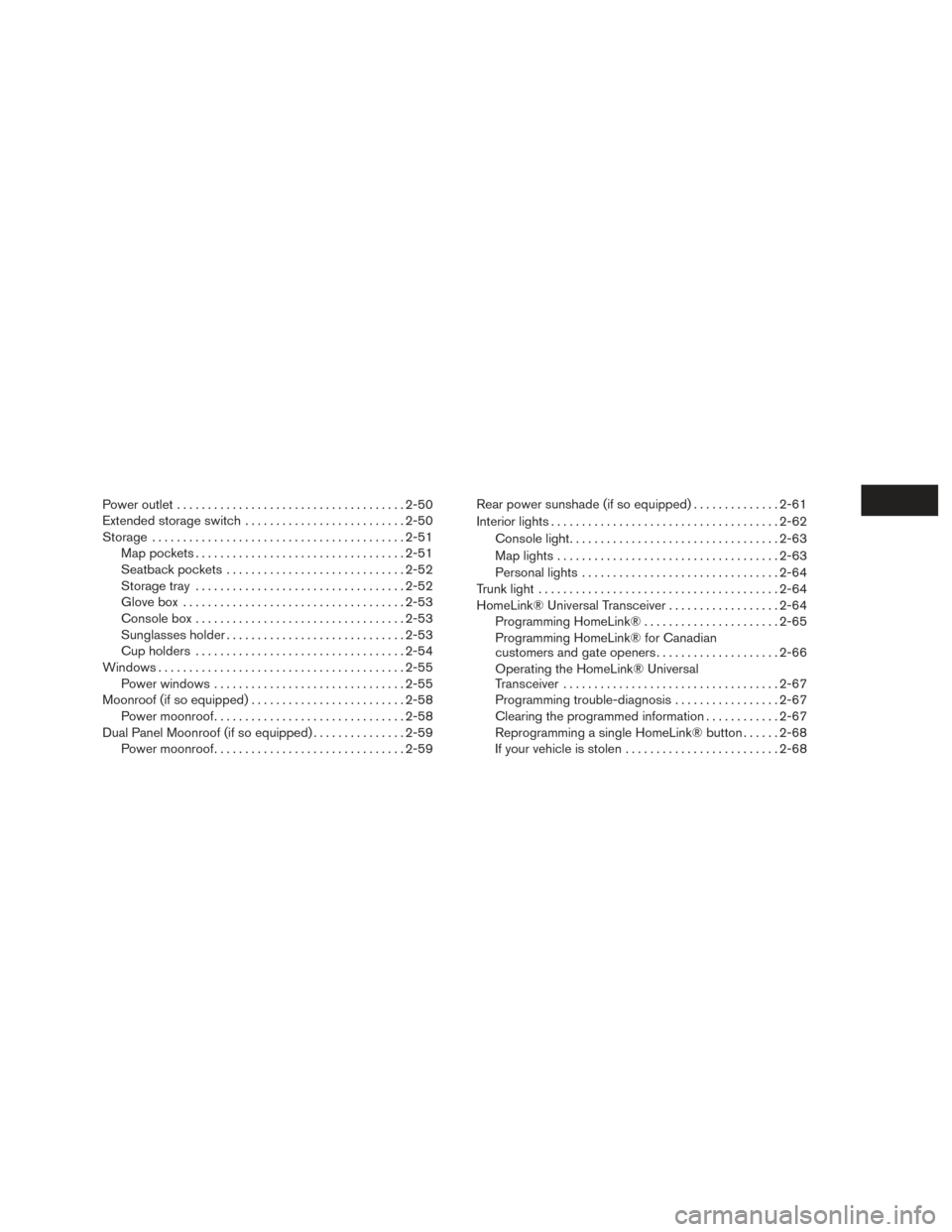
Power outlet..................................... 2-50
Extended storage switch .......................... 2-50
Storage ......................................... 2-51
Map pockets .................................. 2-51
Seatback pockets ............................. 2-52
Storage tray .................................. 2-52
Glove box .................................... 2-53
Console box .................................. 2-53
Sunglasses holder ............................. 2-53
Cup holders .................................. 2-54
Windows ........................................ 2-55
Power windows ............................... 2-55
Moonroof (if so equipped) ......................... 2-58
Power moonroof ............................... 2-58
Dual Panel Moonroof (if so equipped) ...............2-59
Power moonroof ............................... 2-59Rear power sunshade (if so equipped)
..............2-61
Interior lights ..................................... 2-62
Console light .................................. 2-63
Map lights .................................... 2-63
Personal lights ................................ 2-64
Trunk light ....................................... 2-64
HomeLink® Universal Transceiver ..................2-64
Programming HomeLink® ......................2-65
Programming HomeLink® for Canadian
customers and gate openers ....................2-66
Operating the HomeLink® Universal
Transceiver ................................... 2-67
Programming trouble-diagnosis .................2-67
Clearing the programmed information ............2-67
Reprogramming a single HomeLink® button ......2-68
If your vehicle is stolen ......................... 2-68
Page 110 of 406
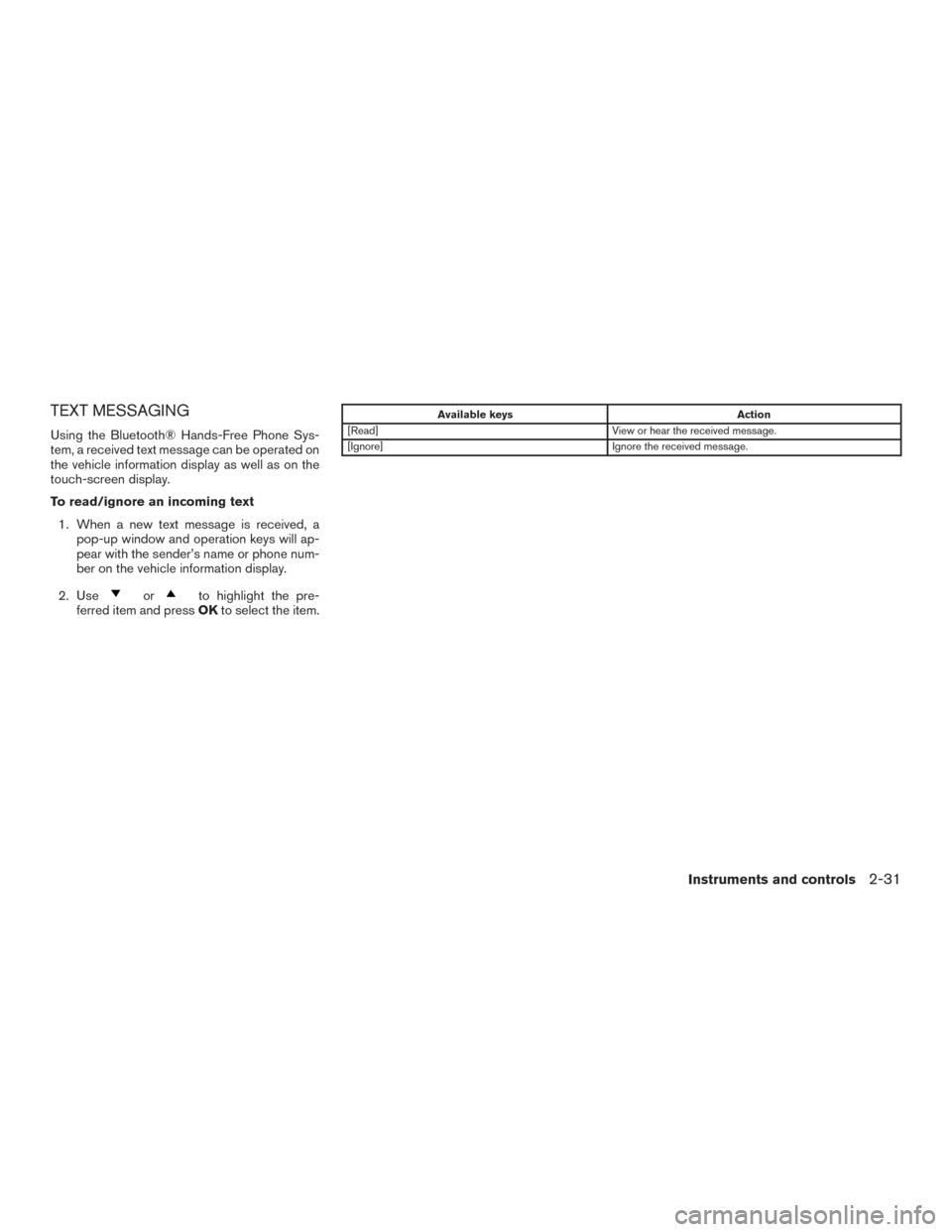
TEXT MESSAGING
Using the Bluetooth® Hands-Free Phone Sys-
tem, a received text message can be operated on
the vehicle information display as well as on the
touch-screen display.
To read/ignore an incoming text1. When a new text message is received, a pop-up window and operation keys will ap-
pear with the sender’s name or phone num-
ber on the vehicle information display.
2. Use
orto highlight the pre-
ferred item and press OKto select the item.
Available keys Action
[Read] View or hear the received message.
[Ignore] Ignore the received message.
Instruments and controls2-31
Page 116 of 406
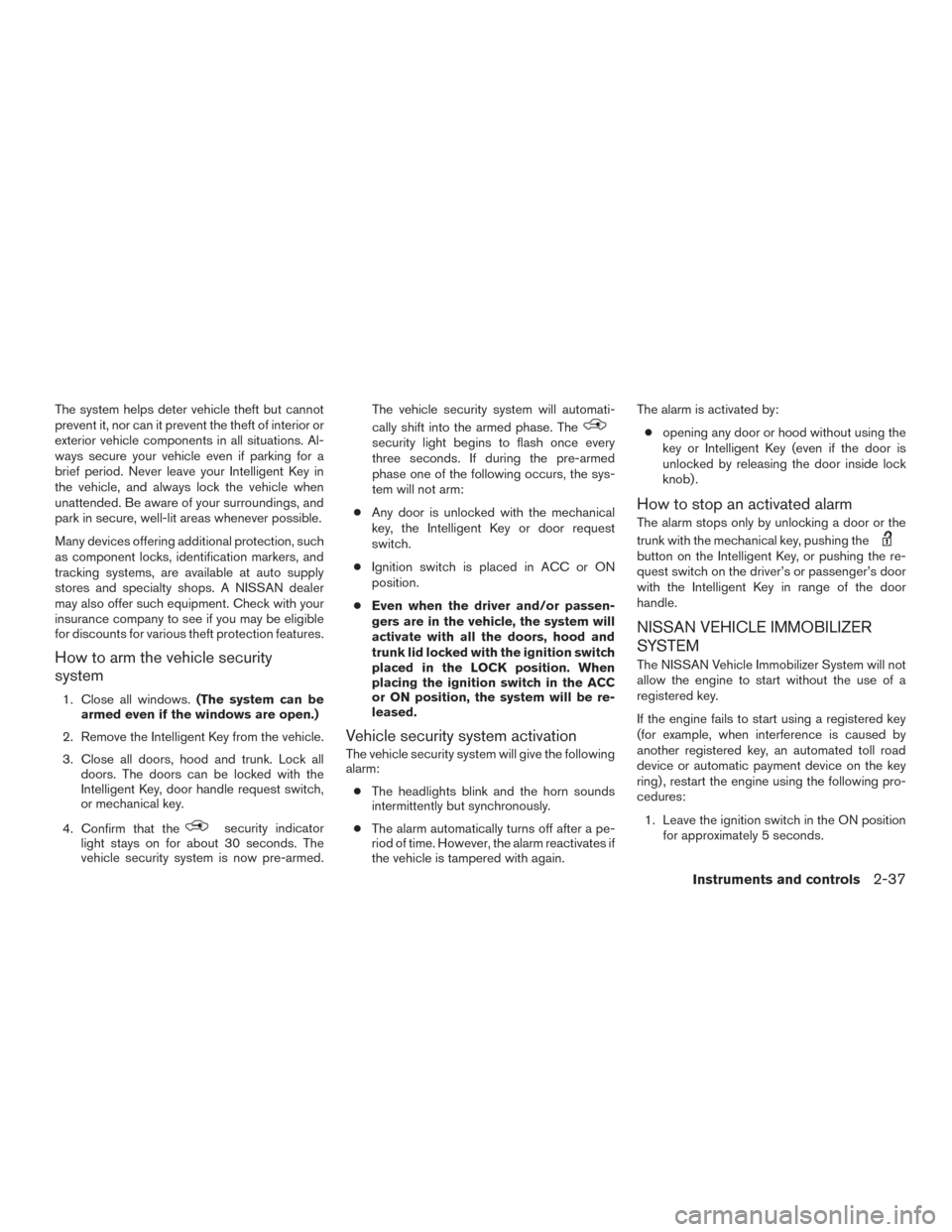
The system helps deter vehicle theft but cannot
prevent it, nor can it prevent the theft of interior or
exterior vehicle components in all situations. Al-
ways secure your vehicle even if parking for a
brief period. Never leave your Intelligent Key in
the vehicle, and always lock the vehicle when
unattended. Be aware of your surroundings, and
park in secure, well-lit areas whenever possible.
Many devices offering additional protection, such
as component locks, identification markers, and
tracking systems, are available at auto supply
stores and specialty shops. A NISSAN dealer
may also offer such equipment. Check with your
insurance company to see if you may be eligible
for discounts for various theft protection features.
How to arm the vehicle security
system
1. Close all windows.(The system can be
armed even if the windows are open.)
2. Remove the Intelligent Key from the vehicle.
3. Close all doors, hood and trunk. Lock all doors. The doors can be locked with the
Intelligent Key, door handle request switch,
or mechanical key.
4. Confirm that the
security indicator
light stays on for about 30 seconds. The
vehicle security system is now pre-armed. The vehicle security system will automati-
cally shift into the armed phase. The
security light begins to flash once every
three seconds. If during the pre-armed
phase one of the following occurs, the sys-
tem will not arm:
● Any door is unlocked with the mechanical
key, the Intelligent Key or door request
switch.
● Ignition switch is placed in ACC or ON
position.
● Even when the driver and/or passen-
gers are in the vehicle, the system will
activate with all the doors, hood and
trunk lid locked with the ignition switch
placed in the LOCK position. When
placing the ignition switch in the ACC
or ON position, the system will be re-
leased.
Vehicle security system activation
The vehicle security system will give the following
alarm:
● The headlights blink and the horn sounds
intermittently but synchronously.
● The alarm automatically turns off after a pe-
riod of time. However, the alarm reactivates if
the vehicle is tampered with again. The alarm is activated by:
● opening any door or hood without using the
key or Intelligent Key (even if the door is
unlocked by releasing the door inside lock
knob) .
How to stop an activated alarm
The alarm stops only by unlocking a door or the
trunk with the mechanical key, pushing the
button on the Intelligent Key, or pushing the re-
quest switch on the driver’s or passenger’s door
with the Intelligent Key in range of the door
handle.
NISSAN VEHICLE IMMOBILIZER
SYSTEM
The NISSAN Vehicle Immobilizer System will not
allow the engine to start without the use of a
registered key.
If the engine fails to start using a registered key
(for example, when interference is caused by
another registered key, an automated toll road
device or automatic payment device on the key
ring) , restart the engine using the following pro-
cedures:
1. Leave the ignition switch in the ON position for approximately 5 seconds.
Instruments and controls2-37